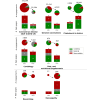Medical Misinformation in Polish on the World Wide Web During the COVID-19 Pandemic Period: Infodemiology Study
- PMID: 38551638
- PMCID: PMC10984342
- DOI: 10.2196/48130
Medical Misinformation in Polish on the World Wide Web During the COVID-19 Pandemic Period: Infodemiology Study
Abstract
Background: Although researchers extensively study the rapid generation and spread of misinformation about the novel coronavirus during the pandemic, numerous other health-related topics are contaminating the internet with misinformation that have not received as much attention.
Objective: This study aims to gauge the reach of the most popular medical content on the World Wide Web, extending beyond the confines of the pandemic. We conducted evaluations of subject matter and credibility for the years 2021 and 2022, following the principles of evidence-based medicine with assessments performed by experienced clinicians.
Methods: We used 274 keywords to conduct web page searches through the BuzzSumo Enterprise Application. These keywords were chosen based on medical topics derived from surveys administered to medical practitioners. The search parameters were confined to 2 distinct date ranges: (1) January 1, 2021, to December 31, 2021; (2) January 1, 2022, to December 31, 2022. Our searches were specifically limited to web pages in the Polish language and filtered by the specified date ranges. The analysis encompassed 161 web pages retrieved in 2021 and 105 retrieved in 2022. Each web page underwent scrutiny by a seasoned doctor to assess its credibility, aligning with evidence-based medicine standards. Furthermore, we gathered data on social media engagements associated with the web pages, considering platforms such as Facebook, Pinterest, Reddit, and Twitter.
Results: In 2022, the prevalence of unreliable information related to COVID-19 saw a noteworthy decline compared to 2021. Specifically, the percentage of noncredible web pages discussing COVID-19 and general vaccinations decreased from 57% (43/76) to 24% (6/25) and 42% (10/25) to 30% (3/10), respectively. However, during the same period, there was a considerable uptick in the dissemination of untrustworthy content on social media pertaining to other medical topics. The percentage of noncredible web pages covering cholesterol, statins, and cardiology rose from 11% (3/28) to 26% (9/35) and from 18% (5/28) to 26% (6/23), respectively.
Conclusions: Efforts undertaken during the COVID-19 pandemic to curb the dissemination of misinformation seem to have yielded positive results. Nevertheless, our analysis suggests that these interventions need to be consistently implemented across both established and emerging medical subjects. It appears that as interest in the pandemic waned, other topics gained prominence, essentially "filling the vacuum" and necessitating ongoing measures to address misinformation across a broader spectrum of health-related subjects.
Keywords: EBM; credibility; credible; disinformation; evidence based medicine; fake news; false; health information; infodemic; infodemiology; information credibility; information quality; infoveillance; misinformation; online health information; online information.
©Małgorzata Chlabicz, Aleksandra Nabożny, Jolanta Koszelew, Wojciech Łaguna, Anna Szpakowicz, Paweł Sowa, Wojciech Budny, Katarzyna Guziejko, Magdalena Róg-Makal, Sławomir Pancewicz, Maciej Kondrusik, Piotr Czupryna, Beata Cudowska, Dariusz Lebensztejn, Anna Moniuszko-Malinowska, Adam Wierzbicki, Karol A Kamiński. Originally published in the Journal of Medical Internet Research (https://www.jmir.org), 29.03.2024.
Conflict of interest statement
Conflicts of Interest: None declared.
Figures



References
-
- Swire-Thompson B, Lazer D. Public health and online misinformation: challenges and recommendations. Annu Rev Public Health. 2020 Apr 02;41:433–451. doi: 10.1146/annurev-publhealth-040119-094127. https://www.annualreviews.org/doi/abs/10.1146/annurev-publhealth-040119-... - DOI - DOI - PubMed
-
- Wierzbicki A. Web Content Credibility. Cham, Switzerland: Springer International Publishing; 2018.
-
- Baines D., Elliott R.J. Defining misinformation, disinformation and malinformation: an urgent need for clarity during the COVID-19 infodemic (Working Paper) University of Birmingham. 2020. [2024-01-01]. https://repec.cal.bham.ac.uk/pdf/20-06.pdf .
Publication types
MeSH terms
LinkOut - more resources
Full Text Sources
Medical

